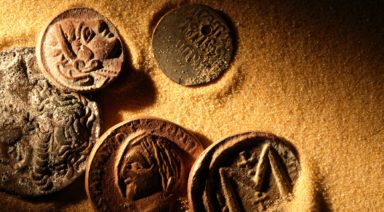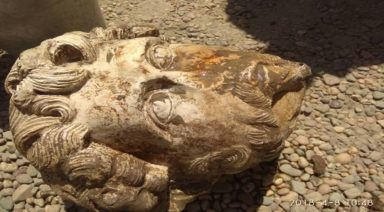The Sphinx Hall of Records: Truth or Tall Tale?

You’ve seen it in the pictures. The Great Sphinx, in Giza, Egypt, is breathtaking all its own, standing about 65 feet high with the Great Pyramid as a backdrop. Tourists from all over the world flock to the site to witness the architectural feat (and of course, pose for pictures next to it). But what if there were more hidden beneath the surface? Some believe there are, in fact, many secrets beneath the Great Sphinx of Giza, namely the Hall of Records, a library full of hidden information. The mystery of the Sphinx begins to unravel with a closer look.
Theories About the Hall of Records
The Hall of Records is said to house piles of documents, scrolls, and other materials with information regarding the lost continent of Atlantis or even extraterrestrials. Some even believe the hall replicates works from the lost Library of Alexandria as well.
Its scholars also attest that the Hall of Records could contain crucial information about the history of Ancient Egypt, too. However, mainstream scholars firmly state there is no such evidence the Hall of Records exists.
To this, believers claim further investigation has been blocked by the Egyptian government and mainstream archaeologists.
It is said the discovery of the Hall of Records would have significant effects on our understanding of world history, specifically the origin of the Ancient Egyptian civilizations. While some write off the study as pseudoarchaeology, others maintain the Hall of Records could indeed be real.
The existence of such an underground library was referenced by Herodotus, who said in Histories’, Book, II, 148:
“This I have actually seen, a work beyond words. For if anyone put together the buildings of the Greeks and display of their labors, they would seem lesser in both effort and expense to this labyrinth … Even the pyramids are beyond words, and each was equal to many and mighty works of the Greeks. Yet the labyrinth surpasses even the pyramids.”
The Psychic Readings of Edgar Cayce
If you asked those from the Association for Research and Enlightenment, a multi-million-dollar organization in Virginia Beach in the United States, they would likely direct you to the teachings and prophecies of Edgar Cayce, an American psychic. Cayce prophesied the Hall of Records would be discovered and opened between 1996 and 1998, connected to the second coming of Christ.
Among Cayce’s purported prophecies is that an Atlantean flying vehicle is buried under the Sphinx and was used to build the Great Pyramid, as well as travel underground tunnels to habitable areas of inner Earth. Other architectural wonders have also been mentioned in the prophecies, including Mayan temples and the holy mountains of Tibet.
Cayce made many references in his prophecies to the hall’s location under the Sphinx: “another in the place of the records that leadeth from the Sphinx to the hall of records, in the Egyptian land,” “It lies between — or along that entrance from the Sphinx to the temple — or the pyramid; in a pyramid, of course, of its own.” and “for the preservation of the data, that as yet to be found from the chambers of the way between the Sphinx and the pyramid of records.”
Supporters of Cayce maintain that his work confirms the existence of the Hall of Records beneath the Great Sphinx.
Seismic Tests of Underground Spaces
You might wonder why the obvious has not been done — in other words, why has nobody gone in and looked to see whether there is, in fact, a Hall of Records under the Great Sphinx?
The answer to that is apparently, “It’s complicated.”
According to a report on a University of Arizona website, a series of expeditions indeed took place between 1991 and 1993, led by an independent Egyptologist named John Anthony West, who conducted seismic and geological surveys around the Great Sphinx.
Their findings indicated the pattern of erosion on the Sphinx suggests it was carved at the end of the last Ice Age when heavy rains fell in the eastern Sahara. In other words, more than 12,000 years ago — not 4,500, as is widely believed.
Seismic surveys from their research also suggested there may be unexplored tunnels and cavities in the bedrock beneath the Sphinx, including a large rectangular chamber 25 feet beneath the monument’s front paws.
However, further substantiation of these claims is said to have been blocked by the Egyptian government.
The question remains: Is, as the NBC television film “The Message of the Sphinx” attests, the Great Sphinx sitting on a huge secret?
Merkabah Mysticism; The Mystery Behind Ezekiel’s Biblical Vision

Ezekiel is one of the most curious figures in the Old Testament. His visions are reminiscent of visitations from other-dimensional beings, and the Book created in his name — the Book of Ezekiel — is the foundation for Merkava mysticism, a school of thought that has survived to this very day. It takes a discerning and informed mind to parse metaphor from historical reality, but both are equally helpful in discovering more about the mystical path created in the shadow of this most mysterious character of early Jewish mysticism.
Merkava (also spelled Merkabah, Merkaba, and Merkavah) is the Hebrew word for “chariot,” and it refers to the throne-chariot of God described by the prophet Ezekiel. So powerful and moving was the description given by Ezekiel that a sect of devotees created Merkavah mysticism, which began to flourish in ancient Palestine during the 1st century AD. When the Jews lost their homeland and were sent wandering to the corners of the earth, the center of Merkava mysticism was relocated from the 7th to the 11th century in Babylonia.
Overlapping with Hekhalot literature, the story of Ezekiel’s vision tends to be grouped within the same category of biblical passages as the Dead Sea Scrolls found at the Qumran caves, the Book of Enoch, and other biblical Apocrypha.




































